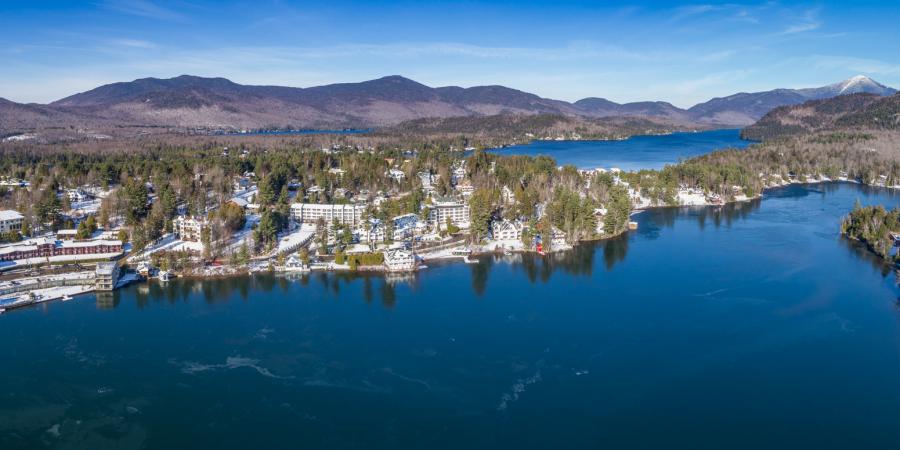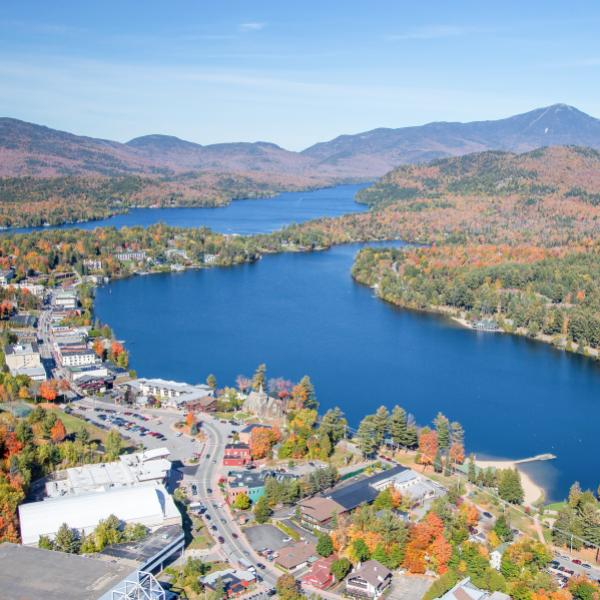Mirror Lake is the gem of the Village of Lake Placid and beloved by many watershed residents and visitors. Unfortunately, the lake is facing serious threats from road salt runoff entering the lake.
Only recently have we come to understand the threat of road salt to Mirror Lake. In 2014, AsRA's Board Chair, Larry Master, enrolled Mirror Lake in the Adirondack Lake Assessment Program (ALAP). This program, run in partnership between Protect the Adirondacks and the Adirondack Watershed Institute (AWI), is a volunteer lake monitoring program. Mirror Lake has been enrolled in the Citizen Statewide Lake Assessment Program (CSLAP) since 1998, unfortunately, this program does not look at salt levels. But ALAP does, and the report on the 2014 sampling season was a wakeup call. Mirror Lake had a surface water chloride concentration nearly 160-times higher than Adirondack lakes without paved roads in their watershed, and was in the 97th percentile out of all the lakes analyzed by ALAP. In short, Mirror Lake is one of the saltiest lakes in the Adirondacks.
The Ausable River Association (AsRA) and AWI began a partnership in 2015 to study Mirror Lake and the Chubb River watershed, which comprises the entire Village of Lake Placid. Together, our professional and technical expertise allows us to tailor research and monitoring programs to specific threats. As we learned more about the impact of road salt on Mirror Lake, we realized there was a lot more we needed to do to solve this problem.
We have the ability to not only assess the condition of the surface of the lake, we are also able to look at the entire water column, from the top of the lake to the bottom. We do this bi-weekly from the time the ice goes out in the spring, until the lake freezes in the winter. Our monitoring doesn't stop when the lake freezes, as soon as the ice is safe we are back out, keeping a close eye on the lake throughout the winter.
One of the early revelations was the elevated chloride concentrations observed in the water at the bottom of the lake. The bottom water chloride concentrations can be twice as high as those at the surface (Figure 1). Since our first sampling visit to the lake in May 2015, we have been wondering how high salt concentrations build up at the lake bottom and why they persist throughout the summer.
In early 2016, we began to understand what was going on in a little more detail. In February and March of that year, we collected water samples from every stormwater outfall around the lake. We found chloride concentrations as high as 900 mg/L, thousands of times higher than the water entering the lake at its inlet from Echo Pond. We also found that there were high concentrations coming from around the entire lake. The salt pollution wasn't just due to the salting of the state road along main street. Contributions from the Village salting the sidewalks, and private residents and businesses, are also important.
What was even more interesting was that we observed runoff settling to the bottom of the lake and building up throughout the winter and early spring. We tracked a similar phenomenon over the winter of 2016-2017. In these instances, salt laden runoff is denser than the water in the lake. Since Mirror Lake is a small waterbody, that runoff flows along the lake bottom and accumulates in the very bottom of the lake.
This left one very important outstanding question: why does this layer of saltier water persist throughout the summer? It should mix throughout the water column during the spring mixing period. This year, we finally had enough data to understand and answer this question. In early 2017, we documented that the lake did not completely mix. Mixing, or turnover, is an important natural process that replenishes oxygen and nutrients throughout the water column.
With the data we have been collecting we are able understand and model physical processes occurring in the lake. Our modeling of the energy required to mix the lake in the spring shows that the presence of salt over the winter increases the energy required to mix the lake in the spring by 75-times. In 2016, there was less salt buildup, as a result the increase in the energy required to mix the lake was only 3-times higher. In that year, the lake completely mixed.
Why does spring mixing matter? The most important reason is because it redistributes oxygen into the deep waters of the lake before the summer stratified period. This is critical for the survival of cold-water fish species, such as the native Lake Trout that live in Mirror Lake. Without replenishing the oxygen at the lake bottom, the Lake Trout are forced into a narrow band of water that is both cool enough and has enough oxygen. The lack of oxygen in the lake bottom also threatens zooplankton and other organisms that live in the lake.
AsRA is expanding our work around Mirror Lake pursuing the research necessary to help the community make smart decisions to address this problem. We are working with the Town, Village, and local businesses to help them track, optimize, and eventually reduce their salt usage. The road to recovery for Mirror Lake will be long, but we are confident we are on the right path.



